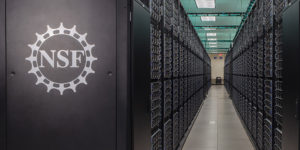The Covid-19 pandemic has brought into sharp relief how small elements of a virus can play a crucial role in combating it with therapeutic drugs and vaccines. In Covid’s case, this research has included highly detailed simulations of viral features like the spike protein and the glycan shield; now, researchers from the University of Delaware and Los Alamos National Laboratory (LANL) have teamed up to apply supercomputing to another devastating virus—HIV-1—in a quest to understand what may be similarly important pharmaceutical targets.
This research centers around HIV-1’s spherical lipid bilayer, called the liposome—two thin layers of fatty molecules that envelop the rest of the virus. Within the liposome, the researchers were particularly interested in a mechanism known as “lipid flip-flop.” Through this flip-flop, lipids found in the “outside” layer of molecules swap to the inner layer, and vice versa. (These layers are known as “leaflets.”)
The research team developed a high-resolution model of HIV-1’s liposome structure, capturing the 24-nanometer-wide structure and its two dozen chemical constituents across hundreds of thousands of simulated molecules. This model was created with a coarse-grained lipid simulation model called MARTINI.
“This work represents an investigation of the HIV-1 liposome at full-scale, and with an unprecedented level of chemical complexity,” said Alex Bryer, a PhD student in the Perilla Laboratory at the University of Delaware, in an interview with Jorge Salazar at the Texas Advanced Computing Center (TACC).
To run MARTINI at this scale, the researchers needed supercomputing power—and for that, they turned to the NSF’s Extreme Science and Engineering Discovery Environment (XSEDE), which provided them with an allocation of time on TACC’s Stampede2 system (10.7 Linpack petaflops, pictured in the header) and the Bridges-2 system at the Pittsburgh Supercomputing Center (PSC). Further work was performed on LANL’s Grizzly system (1.5 Linpack petaflops), Blue Waters at the National Center for Supercomputing Applications (NCSA) and TACC’s Frontera system (23.5 Linpack petaflops).
“Our study wouldn’t have been possible without XSEDE resources,” Bryer said. “We can achieve some very high sampling efficiencies using Stampede2 Skylake nodes, both to run the simulations and perform analyses. … We also used quite a bit of the high memory nodes on Bridges-2 of PSC.”

“On Frontera we were able to classify the volume surrounding the vesicle quickly and process our data in minutes,” he added. “We estimated it might take about three weeks if we were to run the analysis in a serial naive implementation.”
The simulations shed light on a key feature of the liposome: its asymmetry. The researchers found that this symmetry occurs even in the absence of key proteins and is a causal factor for broader properties of the membrane, such as the displacement between leaflets. Another important area in play: lipid microdomains, which are formed due to this asymmetry and are crucial for HIV-1’s infection process. “What we showed was that these microdomains can form in the vesicle without the aid of proteins,” Bryer said. “They seem to emerge spontaneously.”
Now, the simulations have been transferred to the University of Delaware’s own cluster, DARWIN, a 105-node system that is also XSEDE-allocated.
To learn more about this research, read the reporting from TACC’s Jorge Salazar.



























































